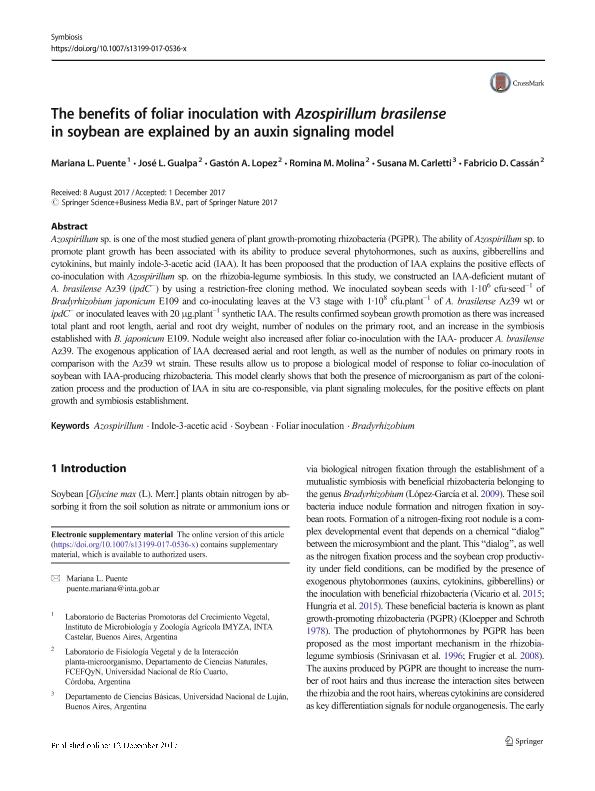Mostrar el registro sencillo del ítem
dc.contributor.author
Puente, Mariana L.
dc.contributor.author
Gualpa, José Luis

dc.contributor.author
Lopez, Gaston Alberto

dc.contributor.author
Molina, Romina Micaela

dc.contributor.author
Carletti, Susana M.
dc.contributor.author
Cassan, Fabricio Dario

dc.date.available
2018-12-10T16:49:26Z
dc.date.issued
2017-12
dc.identifier.citation
Puente, Mariana L.; Gualpa, José Luis; Lopez, Gaston Alberto; Molina, Romina Micaela; Carletti, Susana M.; et al.; The benefits of foliar inoculation with Azospirillum brasilense in soybean are explained by an auxin signaling model; Springer; Symbiosis; 76; 1; 12-2017; 41-49
dc.identifier.issn
0334-5114
dc.identifier.uri
http://hdl.handle.net/11336/66184
dc.description.abstract
Azospirillum sp. is one of the most studied genera of plant growth-promoting rhizobacteria (PGPR). The ability of Azospirillum sp. to promote plant growth has been associated with its ability to produce several phytohormones, such as auxins, gibberellins and cytokinins, but mainly indole-3-acetic acid (IAA). It has been propoosed that the production of IAA explains the positive effects of co-inoculation with Azospirillum sp. on the rhizobia-legume symbiosis. In this study, we constructed an IAA-deficient mutant of A. brasilense Az39 (ipdC−) by using a restriction-free cloning method. We inoculated soybean seeds with 1·106 cfu·seed−1 of Bradyrhizobium japonicum E109 and co-inoculating leaves at the V3 stage with 1·108 cfu.plant−1 of A. brasilense Az39 wt or ipdC− or inoculated leaves with 20 μg.plant−1 synthetic IAA. The results confirmed soybean growth promotion as there was increased total plant and root length, aerial and root dry weight, number of nodules on the primary root, and an increase in the symbiosis established with B. japonicum E109. Nodule weight also increased after foliar co-inoculation with the IAA- producer A. brasilense Az39. The exogenous application of IAA decreased aerial and root length, as well as the number of nodules on primary roots in comparison with the Az39 wt strain. These results allow us to propose a biological model of response to foliar co-inoculation of soybean with IAA-producing rhizobacteria. This model clearly shows that both the presence of microorganism as part of the colonization process and the production of IAA in situ are co-responsible, via plant signaling molecules, for the positive effects on plant growth and symbiosis establishment.
dc.format
application/pdf
dc.language.iso
eng
dc.publisher
Springer

dc.rights
info:eu-repo/semantics/openAccess
dc.rights.uri
https://creativecommons.org/licenses/by-nc-sa/2.5/ar/
dc.subject
Azospirillum
dc.subject
Bradyrhizobium
dc.subject
Foliar Inoculation
dc.subject
Indole-3-Acetic Acid
dc.subject
Soybean
dc.subject.classification
Otras Biotecnología Agropecuaria

dc.subject.classification
Biotecnología Agropecuaria

dc.subject.classification
CIENCIAS AGRÍCOLAS

dc.title
The benefits of foliar inoculation with Azospirillum brasilense in soybean are explained by an auxin signaling model
dc.type
info:eu-repo/semantics/article
dc.type
info:ar-repo/semantics/artículo
dc.type
info:eu-repo/semantics/publishedVersion
dc.date.updated
2018-12-06T14:44:52Z
dc.identifier.eissn
1878-7665
dc.journal.volume
76
dc.journal.number
1
dc.journal.pagination
41-49
dc.journal.pais
Alemania

dc.journal.ciudad
Philadelphia
dc.description.fil
Fil: Puente, Mariana L.. Instituto Nacional de Tecnología Agropecuaria. Centro de Investigación en Ciencias Veterinarias y Agronómicas. Instituto de Microbiología y Zoología Agrícola; Argentina
dc.description.fil
Fil: Gualpa, José Luis. Consejo Nacional de Investigaciones Científicas y Técnicas. Centro Científico Tecnológico Conicet - Córdoba; Argentina. Universidad Nacional de Río Cuarto. Facultad de Ciencias Exactas Fisicoquímicas y Naturales; Argentina
dc.description.fil
Fil: Lopez, Gaston Alberto. Consejo Nacional de Investigaciones Científicas y Técnicas. Centro Científico Tecnológico Conicet - Córdoba; Argentina. Universidad Nacional de Río Cuarto. Facultad de Ciencias Exactas Fisicoquímicas y Naturales; Argentina
dc.description.fil
Fil: Molina, Romina Micaela. Consejo Nacional de Investigaciones Científicas y Técnicas. Centro Científico Tecnológico Conicet - Córdoba; Argentina. Universidad Nacional de Río Cuarto. Facultad de Ciencias Exactas Fisicoquímicas y Naturales; Argentina
dc.description.fil
Fil: Carletti, Susana M.. Universidad Nacional de Luján; Argentina
dc.description.fil
Fil: Cassan, Fabricio Dario. Consejo Nacional de Investigaciones Científicas y Técnicas. Centro Científico Tecnológico Conicet - Córdoba; Argentina. Universidad Nacional de Río Cuarto. Facultad de Ciencias Exactas Fisicoquímicas y Naturales; Argentina
dc.journal.title
Symbiosis

dc.relation.alternativeid
info:eu-repo/semantics/altIdentifier/doi/https://dx.doi.org/10.1007/s13199-017-0536-x
dc.relation.alternativeid
info:eu-repo/semantics/altIdentifier/url/https://link.springer.com/article/10.1007/s13199-017-0536-x
Archivos asociados
